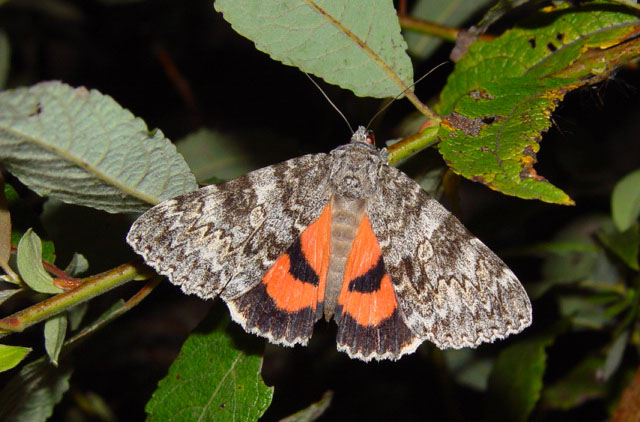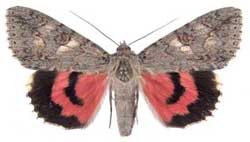
| faustina cleopatra; 58 mm; Head and thorax dark bluish grey; abdomen brownish grey.
Primaries dark bluish grey. Transverse lines, reniform and sub-reniform indistinct with some yellowish brown shading on upper surface.
Orange to pinkish hw with relatively narrow bands, fringe (unbroken) white on exterior margin, grey near abdomen. western BC, but not coastal |
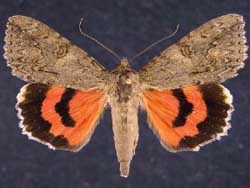
| faustina; 58 mm:
Forewing markings are relatively weak on almost uniform drab grey-brown ground colour.The two middle "teeth" in the forewing postmedial line are relatively short.
The hindwing inner band is narrow and truncated well before the inner margin. Black extenssions into white hindwing fringe continue as thin lines along veins.
eastern BC |
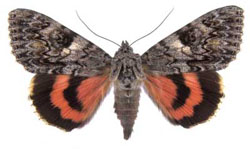
| allusa. White interior outline of terminal line is typical of this species
and two jagged upper "teeth" of postmedial line are typical of most poplar feeders. There is also a dark bar a few mm up from inner
margin of the forewing. Subreniform spot and area interior and above tend to be lighter. willows and poplars. coastal species |
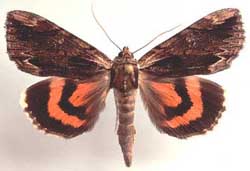
| ** 8857 Catocala ultronia; Ultronia Underwing, wingspan: 50-63mm.
Fws typically gray-brown, with a distinct and very dark inner margin and characteristic light brown patch, underscored
by very dark arc, near wingtip. Underwings can be yellow to orange to salmon. If present, probably only in eastern SE BC
|
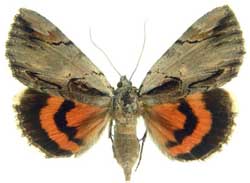
| ** 8857 Catocala ultronia form lucinda;
Ultronia Underwing, wingspan: 50-63mm: In form lucinda most of the forewing is bright grey. On all forms there is
extensive orange-salmon colouration on hw ventral surface, and there is a dark discal lunule.
|
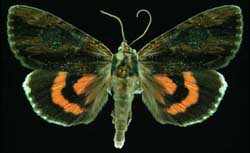
| Catocala ultronia, form nigrescens.
In the melanic form nigrescens, the dorsal forewing is very dark. Even darker subapical arc, basal dash and dash near anal angle are still visible.
Dark basal hairs on hindwing. Harold J. Vermes slide, used with permission from his son. |
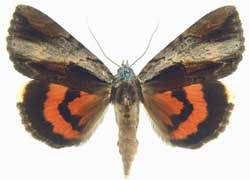
| Catocala ultronia form celia:
In form celia there is a wide, light grey band separating a dark region along inner margin and a dark patch near the apex.
The ventral surface of forewings of all forms has a generous suffusion of orange-salmon scales in the lower half of the median area.
|
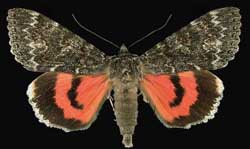
| californica; 65mm.
Fws dark, gritty. Dark, large reniform spot; am/pm lines indistinct.
Subterminal line inwardly lined with light scales. Hw fringe white, checked halfway to outer edge with black,
black lines on veins extending through fringe. Some orange apical bleeding. Black median band ends
well before im. June-August; willow or walnut?? |
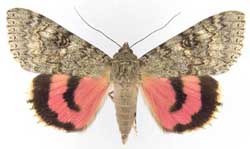
| Catocala hermia;
Hermia Underwing: 58-68mm; pinkish:
Fw almost uniform, grey-brown or clay coloured; thin, yet contrasting lines.
Distinct large double reniform spot. Large concolourous subrenifrom spot usually open.
Hw pinkish red, relatively even, narrow black bands. Inner black band ends before im.
Fringe white, checked, pink/red "bleeding" along outer band, near apex.
|
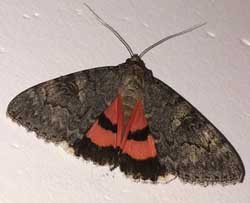
| Catocala hermia form vesta;
Hermia Underwing: 58-68mm; pinkish:
Fw almost uniform, very dark grey; thin, yet contrasting lines.
Distinct large double reniform spot. Large concolourous subrenifrom spot usually open.
Hw pinkish red, relatively even, narrow black bands. Inner black band ends before im.
Fringe white, checked, pink/red "bleeding" along outer band, near apex.
|
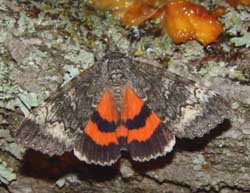 | #8817 briseis TT;
Briseis Underwing; 60-70mm; Fws predominantly mottled dark-grey-brown with some lighter areas 1) between postmedial & subterminal lines, 2) at base of am & pm
lines along inner margin, 3) over subreniform spot running diagonally toward costa. Pm lines do not have greatly elongated and sharly pointed "teeth" near apex.
Hw fringe white & unbroken, inner black band (fairly even) reaches inner margin. |
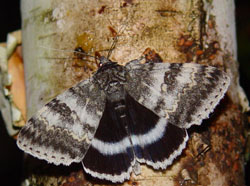 | ** 8803 Catocala relicta;
Forsaken, White, Relict; 70-80mm: Considerable variation with regard to black/white concentrations on fws.
Typical specimens have basal and subterminal areas with blackish scales.
Black hws, with brilliant even white inner band and white fringe, are distinctive. June until October, probably N.& E; poplars and willows
|
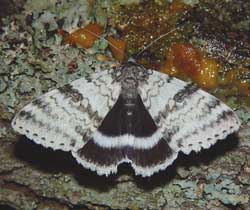
| ** 8803 Catocala relicta;
Forsaken, White, Relict; 70-80mm: Considerable variation with regard to black/white concentrations on fws.
Form clara: basal and subterminal areas predominantly white.
Typical specimens have basal and subterminal areas with blackish scales. Black hws, with brilliant even white inner band and
white fringe, are distinctive. June until October. |
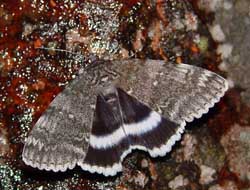
| ** 8803 Catocala relicta; Forsaken, White, Relict; 70-80mm:
Considerable variation with regard to black/white concentrations on fws. Form phrynia:
evenly dusted with grey over entire forewing. Typical specimens have basal and subterminal areas with
blackish scales. Black hws, with brilliant even white inner band and white fringe, are distinctive. June until October; poplars and willows
|
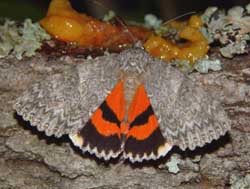
| ** 8822 meskei TT; Meske's Underwing; 65-75mm.
Fws less distinctly marked compared to unijuga, some red-orange at the hindwing apex and just inside the
fringe along the outer margin in meskei that is lacking in unijuga. Fw subreniform spot is opened or connected to the
postmedian line. The hindwing postmedian band nearly straight, turned in and tapering near anal angle. if present,
probably only in extreme SE BC |
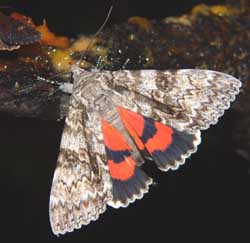
| ** 8821 semirelicta; Semirelict Underwing; 65-75mm.
Fw ground colour is white with dark lines and shadings. Diffuse dark bar runs from center of basal area to outer margin a
few mm above anal angle. Note regular dentation of st line. Inner black bar on hw usually terminates well before
the inner margin. The form "atala" has a forewing that is uniformly grey. Unijuga is usually larger and has less contrasting black lines. The
inner black bar on unijuga usually reaches the inner margin. |
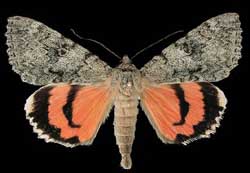
| Catocala junctura; Joined Underwing; 67-85mm.
Fw usually dark brownish-gray to evenly powdered blue-grey w/o significant markings. Doubled reniform spot often obscure. Thin, slightly darker am/pm
lines run from costa to im, not widely spaced at im. Hw salmon or orange-pink, narrow inner black band
turns in sharply, not meeting dark-haired im, distinguishing it from unijuga. |
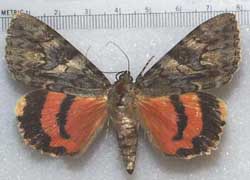
| Catocala jessica;
Jessica Underwing: 75mm: Fw is bluish grey with some brown scaling. Am line is irregular, meets i m almost at midpoint.
Pm line has one upper tooth produced, second is much less so. Third is little more than a sharp point
on smooth curve to fourth tooth, somewhat produced over opening of large subreniform spot. Reniform spot is double and dark in darker region of median area.
|
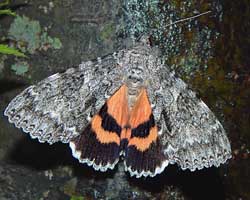
| ** 8805 unijuga;
Once-married; 70-90mm. Fairly wide black hw inner band (almost reaching im.), dark hairs in basal-median area along hw im.;
very distinctive patterning in fw. Meskei tend to have narrower band and dustier (less distinct) looking fw.
Semirelicta tend to have inner bands that terminate well before inner margins. Also note the very white fringe on both the forewings and hindwings.
|
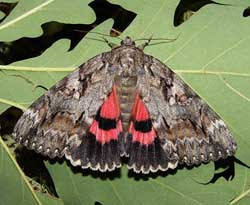
| aholibah; 80-90mm: Fw is mix of grey and brown, with preponderance of brown in subterminal area.
Double reniform spot has diffuse brown outline of inner oval. Subreniform spot is small, distinctly outlined in black,
light coloured and does not connect to pm line. Upper two teeth of pm line are elongate and are followed by relatively smooth line til next tooth below the
subreniform spot. Hindwing salmon or pinkish. |
Catocala aholibah, Saanich, under Gary Oak, July 29, 2014, Larry and Marty Layne
|
